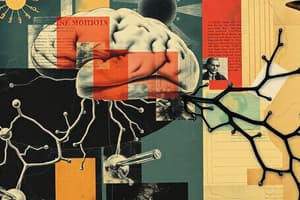Podcast
Questions and Answers
What is the primary role of neurotransmitters?
What is the primary role of neurotransmitters?
- To provide structural support to neurons
- To generate action potentials directly
- To maintain ion balance in neurons
- To transmit signals across a synapse (correct)
Which type of neurotransmitter increases the likelihood of the receiving neuron firing?
Which type of neurotransmitter increases the likelihood of the receiving neuron firing?
- Neuromodulator
- Hormonal neurotransmitter
- Inhibitory neurotransmitter
- Excitatory neurotransmitter (correct)
What triggers the release of neurotransmitters from presynaptic terminals?
What triggers the release of neurotransmitters from presynaptic terminals?
- Calcium ion depletion
- Action potential arrival (correct)
- Increase in sodium ion concentration
- Hyperpolarization of the neuron
What is the main consequence of inhibitory neurotransmitter binding at the postsynaptic site?
What is the main consequence of inhibitory neurotransmitter binding at the postsynaptic site?
Which type of synapse allows for synchronized activity of neurons?
Which type of synapse allows for synchronized activity of neurons?
Which process can terminate the action of a neurotransmitter in the synaptic cleft?
Which process can terminate the action of a neurotransmitter in the synaptic cleft?
Which synapse is most common between axon terminals and dendrites?
Which synapse is most common between axon terminals and dendrites?
What is an example of an excitatory neurotransmitter?
What is an example of an excitatory neurotransmitter?
Study Notes
Synapse
Neurotransmitter Function
- Definition: Neurotransmitters are chemical messengers that transmit signals across a synapse from one neuron to another.
- Types:
- Excitatory neurotransmitters: Increase the likelihood of the receiving neuron firing (e.g., glutamate, acetylcholine).
- Inhibitory neurotransmitters: Decrease the likelihood of the receiving neuron firing (e.g., GABA, glycine).
- Release Mechanism:
- Triggered by an action potential arriving at the presynaptic terminal.
- Calcium ions (Ca²+) influx leads to the fusion of neurotransmitter-containing vesicles with the presynaptic membrane.
- Receptor Binding: Neurotransmitters bind to specific receptors on the postsynaptic membrane, leading to changes in membrane potential.
Synaptic Transmission
- Process:
- Action Potential Arrival: Electrical signal reaches the axon terminal.
- Calcium Influx: Voltage-gated calcium channels open, allowing Ca²+ to enter the neuron.
- Vesicle Fusion: Synaptic vesicles release neurotransmitters into the synaptic cleft.
- Receptor Activation: Neurotransmitters bind to receptors on the postsynaptic neuron.
- Postsynaptic Response:
- Excitatory signal: Depolarization (EPSP).
- Inhibitory signal: Hyperpolarization (IPSP).
- Termination: Neurotransmitter action is terminated by reuptake, enzymatic degradation, or diffusion away from the synapse.
Types of Synapses
-
Chemical Synapses:
- Involve neurotransmitter release.
- Allow for greater modulation and integration of signals.
- More common in the nervous system.
-
Electrical Synapses:
- Direct electrical connection via gap junctions.
- Faster transmission with less delay.
- Allow for synchronized activity of neurons.
-
Types Based on Location:
- Axodendritic: Between axon terminals and dendrites (most common).
- Axosomatic: Between axon terminals and neuron cell bodies.
- Axoaxonic: Between axon terminals of two neurons.
-
Types Based on Function:
- Excitatory Synapses: Promote the generation of action potentials in the postsynaptic neuron.
- Inhibitory Synapses: Suppress action potential generation in the postsynaptic neuron.
Neurotransmitter Function
- Neurotransmitters are essential chemical messengers for signal transmission between neurons across synapses.
- Types include:
- Excitatory neurotransmitters (e.g., glutamate, acetylcholine) that increase the firing likelihood of the receiving neuron.
- Inhibitory neurotransmitters (e.g., GABA, glycine) that decrease this likelihood.
- The release mechanism involves:
- An action potential triggering the influx of calcium ions (Ca²+) at the presynaptic terminal.
- This influx causes neurotransmitter-containing vesicles to fuse with the presynaptic membrane and release their contents.
Synaptic Transmission
- The sequence of synaptic transmission includes:
- Arrival of an action potential at the axon terminal.
- Opening of voltage-gated calcium channels, leading to Ca²+ entry.
- Fusion of synaptic vesicles, resulting in neurotransmitter release into the synaptic cleft.
- Binding of neurotransmitters to receptors on the postsynaptic neuron.
- The postsynaptic response varies:
- Excitatory signals generate depolarization (EPSP).
- Inhibitory signals produce hyperpolarization (IPSP).
- Neurotransmitter action is terminated through reuptake, enzymatic degradation, or diffusion away from the synapse.
Types of Synapses
-
Chemical Synapses:
- Characterized by neurotransmitter release, allowing complex modulation and integration of signals.
- Prevalent throughout the nervous system.
-
Electrical Synapses:
- Feature direct electrical connections via gap junctions, allowing for rapid transmission with minimal delay and promoting synchronized activity among neurons.
-
Synapses are categorized by location:
- Axodendritic: Most common; occur between axon terminals and dendrites.
- Axosomatic: Occur between axon terminals and neuron cell bodies.
- Axoaxonic: Occur between axon terminals of two neurons.
-
Synapses can also be classified by function:
- Excitatory Synapses: Facilitate action potential generation in the postsynaptic neuron.
- Inhibitory Synapses: Inhibit action potential generation in the postsynaptic neuron.
Studying That Suits You
Use AI to generate personalized quizzes and flashcards to suit your learning preferences.
Description
This quiz covers the essential concepts of neurotransmitter functions and the processes involved in synaptic transmission. It includes definitions, types of neurotransmitters, and the detailed mechanics of how signals are transmitted across synapses. Test your knowledge on the chemical messengers that play a crucial role in neuron communication.




